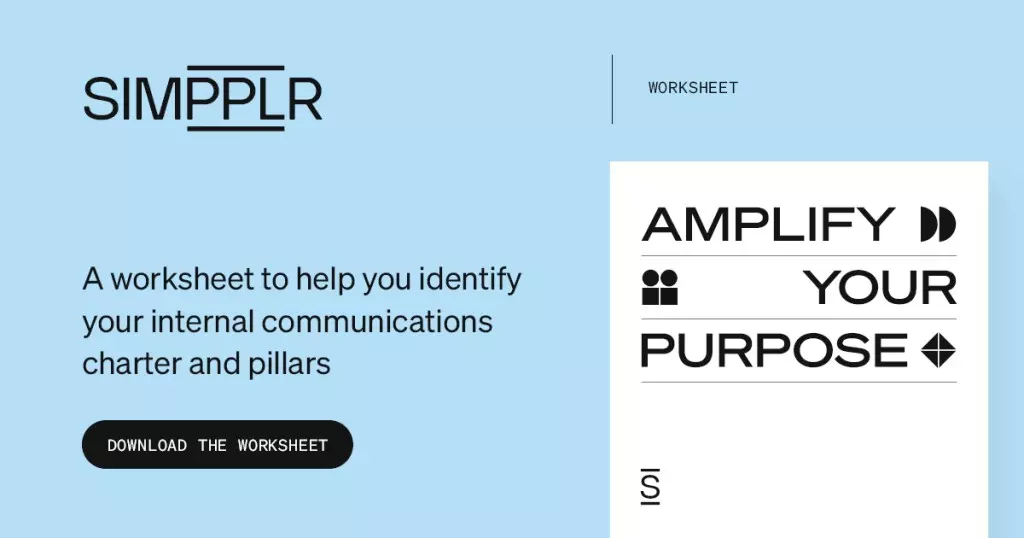A good internal communication plan is critical to how a business operates and functions. Despite its importance and everyone’s good intentions, we have found that not all internal communication teams have a strategic internal communication plan in place. The lack of a strategic plan tends to manifest in various aspects: it can influence the team’s operation, alter communication with staff, and often can significantly affect the overall business performance.
An effective internal communication plan helps build employees’ trust in leadership, facilitates different teams working together, and aligns employees with company goals.
What is Internal Communications Planning?
Effective communication in the workplace is crucial. Building an internal communication plan is an optimal method to impact and boost employee engagement, which improves retention rates and productivity in the workforce, not to mention business results.
A well-developed plan clearly defines how teams and departments communicate with employees and what is required to achieve important business goals. It should be tied to the organization’s strategic plan including its mission, vision, values, and business-critical KPIs.
Why do you need an Internal Communications Plan?
An internal communications plan is a necessity for a multitude of reasons. When a strong communication plan is in place, employees tend to be more engaged, which in turn leads to loyalty, motivation and productivity. The absence of a plan can often lead to poor internal communication, potentially detrimental to your business. This could also result in low employee morale, decreased productivity, and, ultimately, unsatisfactory business outcomes.
Having a clear-cut plan provides a roadmap on how to communicate with employees on a consistent basis so that they feel informed on organizational news, business updates, and goals for the business. By staying aware, employees know when and where — and most importantly, how and why — they can take action to help achieve these objectives.
A well-constructed plan keeps communicators centered on key efforts so that they’re working on projects that are crucial to the business effectively and efficiently. In doing so, they operate as true business partners rather than simply running a glorified arts and crafts department.
A solid plan also helps define what communication strategies are essential for the organization to focus on and what the timeline will look like for implementation. A plan guides the team on how each initiative will be valuable to the employees and the organization and its impact on the business.
Most importantly, creating a strategic plan ensures that business leaders align on the significance and impact of internal communications and how it serves critical business needs. There’s a secret bonus hidden in this part that works very much in your favor.
Since your senior leaders will have a hand in agreeing on what’s in your internal communication plan, you end up with an excellent strategy they’ve all said “yes” to, which makes it a whole lot easier for your communication team to say “no” to other requests that consistently tend to distract you from doing your most strategic work.
How Do You Create Effective Internal Communications?
Have you ever had writer’s block when called upon to produce a new internal comms campaign? You’re not alone! The constant stream of company-wide updates, administrative messages, and employee engagement campaigns is enough for even the most seasoned internal communications professional to feel creatively burned out.
Why is it then that some organizations can create consistently effective internal communications across their employee experience?
The answer lies in the methodology many employee communications veterans implement when producing their internal communications strategy. Like many creative writers, the method they approach creating content can drastically inspire fresh ideas and keep your content engaging.
Here are some tips successful intranet managers and communication leaders use to keep their content initiatives engaging.
Step One: Choose an Audience Persona
Before approaching the campaign creation process, it is crucial to understand your audience and how they will consume the information. Different audiences will view the information you give them in different ways, and it is essential to ensure that the desired message is delivered and understood appropriately.
Write down who you are addressing and what they want out of the campaign. You can have multiple audiences for one campaign; ensure you clearly define who they are and how they will view your content.
Step Two: Set The Campaign’s Objective
The second step should determine your campaign’s desired outcome. This definition can include which information you want your audience to walk away with, an action you want your readers to take, or numerous other outcomes. Before creating your campaign, define and prioritize the objective in your copy and design creation.
Rather than making a list of general outcomes (e.g., engage employees, fill our editorial schedule, etc.), clearly state one action you want your audience to perform after consuming your campaign. Use that guiding statement as a beacon to focus your creative efforts and ensure your campaign is effective.
Step Three: Find the Right Voice
There is a common fallacy that the person writing the communication should always be the attributing author, which isn’t always the most effective strategy. Instead, consider your content’s audience and desired outcome to identify if a stronger voice would be more effective in conveying your message.
For instance, while you may be writing about new company policies for compliance with SOC2, it would be more effective for that piece of content to come from the CIO or IT leader (with their consent, of course!). Once you’ve finalized your campaign, send it to the most influential voice on the subject and ask them for attribution.
Step Four: Write and then Right
The most challenging part of any new piece of content is always the first draft. The most successful communicators always use the first draft to get out all of their ideas and thoughts, and you should follow in their footsteps.
Sit down and set a timer for a set amount of time—it could be 5 minutes or 30 minutes—the constriction of time will give you urgency to get all your thoughts out. Once the time is up, look at your draft and start sculpting your communication.
Use your audience and outcomes guidelines as a compass to navigate your editing process. If you use an alternate voice, ensure the communication sounds appropriate to their unique style. Once you’ve finalized your first edit, try getting feedback from a sample of your selected audience.
Step Five: Distribute
Now that you’ve finalized your content, it is time to make sure it reaches the right audience and that they consume it. Knowing your company’s engagement behavior is critical to successfully driving engagement to your content and choosing the proper communication channels to meet your objective.
Whether you have engagement data to draw on from previous campaigns or know when your company intranet has the highest live users, timing your distribution is vital. One step further, knowing when and where your targeted audience will be active is critical intelligence you need to gather to distribute your content at the right time appropriately and in the right channel (or site). Having access to modern communication tools can make informed distribution easy.
Step Five: FOLLOW-UP and Engage
Your job is not done once your campaign is out there; following up with your audience is crucial to develop the conversation. Remember that your company is a community where a common goal unifies everyone. Like any thriving community (and just like on social media), being interactive and responsive to questions, comments, and other employee feedback will assist with growing relationships with your audience. The opinions and questions you receive can often be a source of inspiration for new content ideas themselves.
Step Six: Draw Inspiration from Analysis
Analytics can be a powerful tool for understanding who is reading your content and how they understand it. Whether you are using an intranet with advanced analytical capabilities or only have access to primary data, the final step of every campaign should be an analytical review. As a baseline, you should understand if the correct audience consumed your content and how they interacted with it. This information will help you plan your editorial calendar and ensure messages get delivered in highly engaging ways.
The next step should be to understand what the content’s audience took action and how effectively it completed its set objective. Catalog your campaigns’ impact and jot down any ideas on how to adjust them in the future. If you have access to a highly advanced platform, you may collect data on how employees feel after reading your content and how it affects their affinity with the company.
How Do You Create an Easy-to-Follow Internal Communications Plan?
There are many different ways to create an internal communications plan. It’s important to find a method that works for your organization and crucial to stick by it once you find it.
Review your current Internal Communications Strategy
Before you begin developing a plan, assess your organization’s current situation. Conducting background research before creating a strategy will help you understand the business needs and employee wants that will be instrumental in the success of your plan.
It’s the perfect opportunity to analyze the strengths and weaknesses of your current internal communications program and find the gaps that can help or hinder your success.
Some important questions to ask as you evaluate your internal communication strategy should be:
- What’s your current situation: How is your current strategy performing? Who is currently involved with your plan, and who can you add to improve it? How close did your last plan get you to achieving your goals?
- Create a list of strengths and weaknesses of your previous internal comms strategy. If you don’t have one, determine the goals you are trying to achieve by creating a plan.
- Conduct a company-wide survey. Surveying your employees is an effective and direct way to gather their feedback.
- Conduct the same kind of survey with your leaders/managers to find out what they need/want/expect from your team and your communication efforts.
- Review existing communication tools to see which ones are effective and the impact they have on your workforce.
- Where do you want to be?: What are your overall company internal communication goals? Are you investing in a new communication platform or revamping current tools?
- Define communication priorities that support your business objectives, such as increasing employee engagement scores or behavior changes and increase in motivation.
- Determine which tools best suit your communication priorities, from internal communication platforms to collaboration tools to instant messaging and video conferencing. Each service serves a different purpose, and some goals may require a combination of multiple channels to ensure business objectives are met.
- How you plan to get there: What do you need to achieve your internal communication objectives? What content and resources will be beneficial for your employees?
- How long it should take: How many resources are needed to reach your objective? Determine between how long it should take vs. a realistic timeline for your team.
- Set realistic goals for your plan taking into account implementation and planning so that you can take more efficient steps towards updating your internal communications strategy.
- Who’s involved: What departments and functions are a part of your team? Is leadership engaged and involved from the get-go?
Define your audience
Organizations have various teams, departments, and functions that must be addressed in your internal communication plan. Your strategy should try to engage everyone across the business but the same messaging can’t be applied to all.
It’s important to segment your audience to cater to the different functions, locations, organizational levels and departments. When creating your plan, it’s important to have content that targets specific audiences, even when it’s internal. Mapping out your content strategy can help address information overload and should focus on delivering relevant information to the right employees.
Organizations need to ensure that they are constantly reviewing their audience targeting to make sure it aligns with their internal communications strategy.
Set SMART Objectives
A useful place to start when creating goals is to develop S.M.A.R.T. objectives. Think about where to take your internal communications plan and strategy. Ask yourself:
Specific: Define what your goals are in clear, simple terms
Measurable: Create quantifiable targets that help you see progress toward your goal
Attainable: Ensure your goals can be achieved within your specified time frame and with the resources you have
Relevant: Create objectives that will have the desired effect on your goal and align with your business model
Time-bound: Develop a timeline to keep your team accountable
What’s your strategy for Internal Communications?
Once your team and organization have aligned on goals, it’s important to develop a strategy before diving right into actions without a plan in place. Look at your organization’s roadmap and determine what approach will help best serve your goals. You can take a few steps to ensure that your strategy is aligned with your goals:
- Review your internal communications plan consistently. Reviewing and updating your plan based on what’s working and where you stand with room for improvement is necessary.
- Audit your communication channels. Evaluate what tools are working for your employees and where any gaps lie so that you can fill them. Remember, not all communication tools work for every employee so get feedback for what’s needed.
- Analyze your data. It’s essential to look at your numbers, whether it’s log-in rates on your modern intranet or click-through rates on a newsletter, but most importantly, data from employee engagement surveys to determine how well your communications is actually performing.
How will you measure success and progress?
Measurement should line up with the SMART objectives you set. Ensure that when you create those goals, you also take time to check in on how well you’re doing on a monthly basis. Test new tactics in your strategy to see if it’s a success or if you need to pivot resources toward a new direction.
Depending on what priorities you have set, what you measure will vary. Creating a monthly report to share with executives and leadership can be valuable to show the impact of internal communications on the workforce and how well (fingers crossed) your strategy is working.
Be sure to measure the outputs (how many clicks, likes, downloads, forwards, shares, attendees, etc.) and the outcomes (what employees think/feel/do differently once they engage with your content). Hint: your business leaders only care about results. While impressive to you, they don’t care at all if your corporate video won 17 awards. They only care how that video moved the needle they are constantly watching.
Identify your internal communication tools
It’s important to determine which internal communication tools your organization needs to create and share content. Different tools are designed for different types of communication. Evaluate what you already have in your technology toolkit and how your organization utilizes each platform. There are countless enterprise collaboration tools available, find what works for your organization.
Depending on the size and geographic location of your organization, you can communicate through several channels, such as:
- Face-to-face communication: The best approach to building a personal connection with employees
- Email: Great method to communicate with employees that are desk workers and for long-forms of personal communication.
- Modern Intranet: A virtual headquarters that contains high-level communication from departments and locations across the organization.
- Online Chat: Great for instant communication and collaborating with a coworker.
Having multiple kinds of technology is key to empowering employees to work efficiently. Not everyone communicates the same way, so it’s important to recognize how to appropriately use each working tool to not only keep employees productive but to preserve company culture and connection. Just keep in mind that high-tech tools are there to help your business facilitate high-touch connections. And it’s those connections and relationships that drive the outcomes you’re seeking, not the tools themselves.

Conclusion
It’s safe to say that internal communication has become an essential part to having engaged, productive employees in a successful business. It’s not just about connecting leadership and executives with employees but also evaluating what organizations can do to improve collaboration and performance from within. After all, your business can’t be successful in the marketplace if it isn’t successful in the workplace.
Having a well-thought-out and structured internal communications plan enables your team and organization to maximize the impact of your communication efforts. It establishes a clear direction and aligns employees toward the same goal.
Planning is one of the most powerful ways to ensure that you have a successful internal communications program. Guarantee your organization a higher rate of engagement, productivity and success. See how Simpplr can help you shine, book a demo today!














